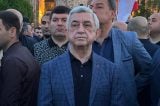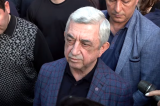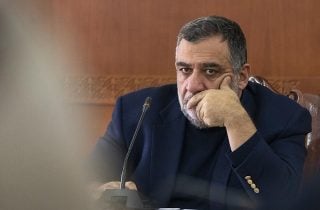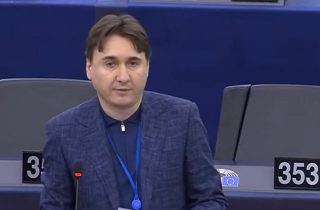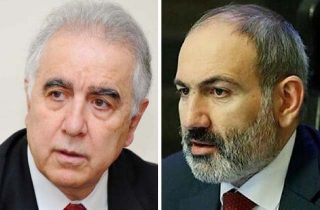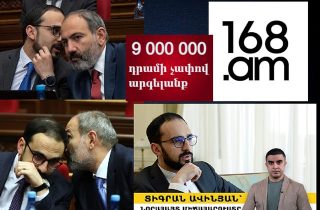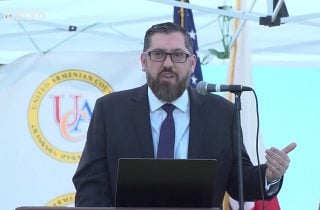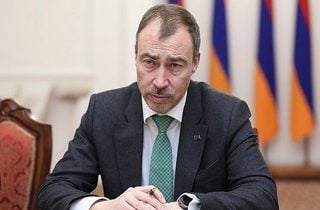Key West Proofreading
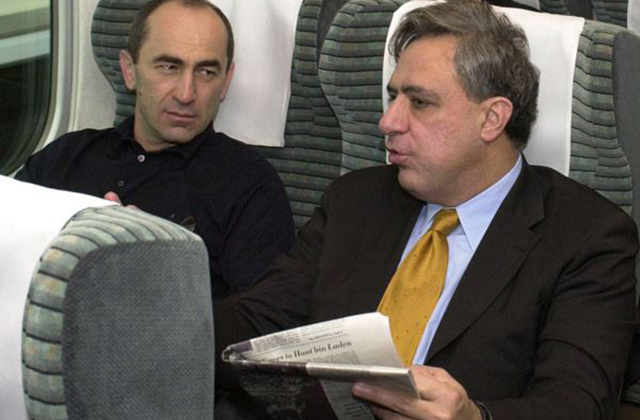
In an interview with Azatutyun Radio on September 3 the second president Robert Kocharyan reflected to the tendencies of NK conflict settlement ongoing stage and attached particular attention on disproportion of the readiness for concessions by the sides. However, Kocharyan wouldn’t be himself, if he didn’t give a meaning to his “diplomatic achievements,” proofreading them both as Key West process and the document, which, in all fairness, may be considered as Kocharyan’s adoptee.
“Throughout 10 years of my presidency, only once, in Key West, we were really close to sign the document, which didn’t occur due to Azerbaijan’s refusal, in fact, during the very signing ceremony. It was package and comprehensive settlement, which had uniting NKR to Armenia on the ground and supposed concession of territories, as well as application of complex means towards security provision,” R.Kocharyan said.
It should be pointed, that the allegation that “signing ceremony” of the document was planned in Key West, slightly said, doesn’t seem credible, as it contradicts the statements made prior to the meeting of the authorities of Armenia and Karabakh. For instance, a month prior to the meeting R.Kocharyan through his spokesperson was stressing principal discordances of the sides. The then spokesperson of Robert Kocharyan—Vahe Gabrielyan was explaining, that if there were principal discordances between Aliyev and Kocharyan, the scope of negotiations would have expanded, and adding, that they “aren’t negotiating around details of the issue settlement, but they attempt to find mutually acceptable principles” (Azg Daily, 28 February, 2001). And the then NKR president Arkadi Ghukasyan during the NKR NA discussions on March 21 was stating that Key West is the development of former meetings, and any document won’t be signed (Azg Daily, 24 March, 2001).
There wouldn’t be any necessity to touch upon the allegation of “signing ceremony,” if it were conditioned by Kocharyan’s intention to highlight Aliyev’s destructiveness only. However, it’s clear from his speech, that an attempt is made to generate a frame of mind, that there was a point on uniting NKR to Armenia in the already prepared document. And R.Kocharyan’s this aspiration already seems intriguing against the background of the developments speeding up in negotiations and domestic policy. And now again it should be reflected to the sources of this settlement stage.
By coming to power, Robert Kocharyan put forward the claim of “Resumption of negotiations around comprehensive (package) settlement without preconditions,” in his turn Aliyev claimed to return to phase-to-phase settlement. However, after a while, on April 28 at the CIS Summit (Moscow) the first bilateral Kocharyan-Aliyev meeting was recorded, and, as further developments showed, Armenian-Azerbaijani mutual concession was reached at the meeting. More correctly, Aliyev agreed to discuss the settlement package variant, with the condition of excluding Karabakh from negotiations through bilateral meetings and launching discussions around the “Goble plan.” Kocharyan obviously accepted Aliyev’s conditions. Moreover, after he was back to Yerevan, he “confessed” that the idea of eliminating Karabakh from negotiations was his. “I was mainly attempting to express my opinion to the president of Azerbaijan not only regarding the approaches, package or step-by-step version, but on participation of the sides inclined for negotiations. It was interesting for himself as well. You know, throughout recent few years, indeed, the sides were attempting to show through the presence of mediators that they are more correct. They were attempting to find arguments against the other side: whose position is more concessive, and whose—extremist? (Hayastany Hanrapetutyun Daily, 1 May, 1998).
S.Sestanovich, Advisor to the Secretary of State on the New Independent States, visited the region in June 1998, who after the meetings with Kocharyan and Aliyev stressed the importance of bilateral negotiations. If we add, that during this American analyst Paul Goble told Voice of America, “I know that many in Armenia share the opinion that borders should be changed or at least their issue should be discussed,” it may be concluded that Kocharyan gave S.Sestanovich guarantees of discussing exchange of territories during negotiations as well.
Yet in 2014 Paul Goble, basically confessed that at the Key West stage the “Goble plan” settlement was being discussed. “As I understand, many of the points on the document on negotiation table were too close to the variant I proposed prior to that.” Upon curious coincidence, P.Goble also considers that at Key West the sides were as close to the settlement as ever.” (“168 Hours,” 8 December 2014).
Now it’s worth passing on to the very negotiations. Kocharyan-Aliyev meetings in Washington, Geneva, again Geneva, and then in Sadarak were of utmost importance for the start of the Key West stage. The Washington meeting launched on April 21 within NATO’s anniversary celebrations, confirmed activation of mediation efforts of the U.S. In the message sent to Kocharyan on June 28, U.S. Secretary of State M.Albright expressed desire to move the ideas covered during the meeting to a more practical course as soon as possible (Hayastany Hanrapetutyun Daily, 29 June, 1999). The July 16 meeting in Geneva was highlighted by M.Albright’s addendum to the proposals by the Co-Chairs. If we add that a year later Peter Rosenbluth uncovered that “the idea of exchange of territories initially raised in the second half of 1999” (Azg Daily, 23 May, 2000), it’ll become clear that “Albright addendum” referred to exchange of territories. The second meeting in Geneva on August 22 was singled out by the statement on resolution to resume negotiations, which edified in reduction of discordances amid the sides. It became clear later that the Sadarak meeting on October 11 was meant to implement amendments made in “Goble plan.”
In an interview with “168 Hours” newspaper 8 December 2014 Paul Goble opened the brackets saying, “I do not think the “Goble Plan” has any place in a resolution now, even as I modified it later in the 1990s, so as to ensure Armenia a land bridge to Iran via an adjustment of the western border of Nakhchivan [Sadarak region—M.K]. it’s interesting enough that after the Sadarak meeting during the press conference in Yerevan, Kocharyan was explaining, “Today in a range of issues we do the work, which the negotiation group or groups should have done after the resumption of negotiations.” (Hayastany Hanrapetutyun daily, 19 October, 1999).
Thus, all the questions on resumption of bilateral meetings have been consumed. Thus, it wasn’t surprising at all, when during the regional visit in the period of October 20-21 S.Sestanovich, Advisor to the Secretary of State on the New Independent States, promising to thoroughly study Karabakh issue at Istanbul Summit, stressed the possibility of reaching to a breakthrough. It should be noted that “breakthrough” in those days was identified with adoption of a joint declaration on Nagorno Karabakh. Moreover, confidence of American diplomats was so big, that even the day following “October 27” in the message sent to Kocharyan, U.S. Vice President A.Gore expressed conviction that “The attack won’t weaken your determination to reach your purposes and support of Armenian people.”
We should have underestimated Kocharyan’s “diplomatic skill,” if we didn’t state that Kocharyan didn’t sign the declaration in Istanbul, however, without reservations he signed the OSCE Istanbul Summit documents, by which preference was given to the principle of territorial integrity in the conflict settlement. Thus, the USA manifested good nature towards Kocharyan through the representative of its administration, “Clinton comprehends the issue that during the Summit leaders of Azerbaijan and Armenia refused to sign a declaration devoted to the conflict settlement. The reason was the terror act in the Armenian Parliament, and Clinton perfectly realizes that time is needed to restore domestic policy consensus.” (Aravot, 23 October, 1999).
It’s worth returning to Kocharyan’s allegation, that the Key West document had uniting NKR to Armenia on the basis. Unfortunately, it’s a fact, that throughout all the period of this stage not only a statement on uniting wasn’t heard, but Armenia’s leadership basically reconfirmed the statements made at the pervious stage, that they don’t lay the idea of reunion or independence on the basis of negotiations. It’s enough to remember Oskanian’s anecdotic formulation—“De facto Artsakh may be independent, de jure—not within Azerbaijan.” It should also be memorized, when Kocharyan adopted “Albright addendum” saying “Current Armenian authorities consider, that for the sake of integration a part of the independence should be conceded,” he didn’t state for unclear reasons, that he anticipated “unity of NKR to Armenia” instead.
It’s also noteworthy, that Kocharyan didn’t mention the right to self-determination on international platforms. For instance, at the UN 53rd session of the General Assembly (September 1998) he only said, “We consider, conflict depth and peculiarities suppose non-standard approaches towards its settlement, on the basis of which should lay principles of equality of the parties to the conflict, exclusion of NK enclave and international security guarantee of its people.” During another speech at OSCE Istanbul Summit (November 1999) Kocharyan didn’t even touch upon the settlement concept, stressing his dialogue with Heydar Aliyev, “Through direct contacts we attempt to assure seriousness of our intentions to one another and to the whole world. In case joint initial agreements are reached with the Minsk Co-Chairs, we’ll need strong support of OSCE.” It’s excessive to state that in his speech by Kocharyan not only protection of the right to self-determination failed to find its place, but Armenia’s continuous blockade by Turkey and Azerbaijan wasn’t condemned as well.
Statements reconfirming exchange of territories continued in 2000. After Kocharyan-Aliyev-Albright meeting on January 29 in Davos the statement of the representative of U.S. Department of State read, “Presidents of Armenia and Azerbaijan in their sincere dialogue have gone beyond the framework of OSCE MG proposals and strive to find more innovative and bold settlement variants.” Azerbaijani Foreign Minister Guliyev uncovered essence of those settlements by the end of the meeting of OSCE MG Co-Chairs in Geneva, “Obtaining a corridor connecting Azerbaijan to Nakhchivan instead of Lachin corridor would be a great success.” (Azg Daily, 24 February, 2000). In a letter spread through the internet in early April Baroness Caroline Cox wrote, that Armenia’s authorities go to big concessions and are going to concede Armenia’s adjacent lands. The Baroness warns, “If current state of affairs isn’t suspended, your leadership in Yerevan will be fatally weak and betrayed to the country” (Azg Daily, 12 April, 2000). Information flow urged Oskanian to partly confess during the press conference that Kocharyan and Aliyev in Davos have touched upon the proposal of NK conflict settlement by exchange of territories near Meghri and Karabakh” (Azg Daily, 13 April, 2000). It’s curious enough, that a few days later after Davos the delegation comprising representatives of Armenia’s political parties, NGOs and press paid a long-term visit to the USA. Amongst the meetings that with Paul Goble attached attention. After negotiations entered into a deadlock, yet in early 2002 French Foreign Ministry and OSCE MG Co-Chair A.Gribkov confirmed that Key West principles anticipated restriction of Armenian leadership to the territory of Meghri. And again in this period, not a single hint on uniting NKR with Armenia wasn’t heard.
Undoubtedly it can’t be excluded though, that initially Robert Kocharyan had illusions, that the idea of exchange of territories will provide favorable ground for uniting NKR to Armenia. Probably, in this very confusion he moved negotiations from OSCE MG format to that of bilateral meetings, as a result of which Karabakh was pushed away from negotiations on its own status. It’s not excluded either that Kocharyan once made unsuccessful attempts to obtain NKR independence or its unity with Armenia for Meghri. However, it’s a fact that, finally, the idea of exchanging Lachin corridor with Meghri was enshrined in the document. There is one variant to prove the opposite: Kocharyan’s office should issue the Key West document.
By the way, the fact that, as compared to other documents, that of Key West is kept secret until now, already seemed not only strange, but rather hazardous, as there may be 2 explanations for that. Either the document plans unequal concessions, or it yet may be put on the negotiation table. In this context, it’s important to understand whether by proofreading the Key West document Kocharyan simply made an attempt to hush up disproportionate concessions made by him at that time or not.
By Marine Karapetyan




